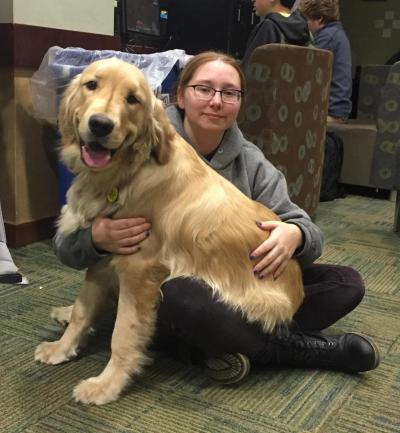Therapy dogs in libraries are not new. Most frequently brought in as "listeners" for young children to build their reading skills, therapy dogs of all sizes can be found in even the most remote library. If your library already has a therapy dog program, it can be an easy transition to include teens in the mix.

Hang with Jake is a weekly therapy-dog session held in the teen room at my library. It has quickly become our highest attended ongoing teen event.
Introducing Jake
Jake is a friendly golden retriever and certified therapy dog who started his career with Saratoga Springs Public Library (SSPL) in our Tail Waggin’ Tutors children’s program. As a 1-year-old, Jake loves playing and has a youthful personality. His handler, Marjorie Johnson, suggested a one-off session with the teens to see how they would interact.
“[Hang with Jake] was so well received," Marjorie said. "Jake did well with the younger kids in the children’s room, but when he entered the teen room, he interacted so much more with that age group. It’s very rewarding for Jake and me to be with the teens.”
Now officially the teen room mascot, Jake regularly gets about 12 teens to hang out with him each Thursday. Everyone wants to pet him, some want to cuddle with him, and others like to play tug-of-war. He is more than just a friendly furry face, though.
Benefits of therapy dogs
UCLA Health’s People-Animal Connection lists animal-assisted therapy research findings, offering multiple studies that prove both mental and physical health benefits of human-dog interactions.
Dogs are uniquely well suited as therapy animals because of their non-judgmental, accepting nature. Marjorie was inspired to find Jake after reading “Until Tuesday: A Wounded Warrior and the Golden Retriever Who Saved Him” by Luis Carlos Montalvan.
“It’s a book about a veteran who was wounded in the war in Iraq, who could hardly leave his apartment because of his injuries and PTSD," Marjorie said. "After working with a golden retriever service dog named Tuesday, he was able to get out and even go back to college and get a degree. Luis and Tuesday traveled all over the country doing book readings and programs. After reading that book, I knew I wanted to have a therapy dog and give comfort to those in need.”

The need may not always be obvious. The teen room at SSPL is an open space for students in grades 7 through 12 to gather and study, do homework or just hang out and play games. We serve teens from five area schools and a robust home-school network. It’s not always a place of peace and quiet, but it has become a melting pot for teens from diverse backgrounds.
Hang with Jake makes it easy for the teens to connect, including students who may be experiencing hardships at home or school. According to a study on the national trends of depression in young adults by the American Academy of Pediatrics, rates of depression among teenagers has increased steadily in the last decade. Therapy dogs can help improve teens’ physical, social, emotional and cognitive function.
Jake and Marjorie agree. “I’ve often said that it’s hard to be in a bad mood when you have a furry golden retriever wagging his tail and so happy to see you," Marjorie said. "I can see from the few visits that we have done so far that the kids really look forward to our visits. One teen asked if Jake could visit every day.”
Many teens told staff that it’s really special for them to have a place to connect with a pet. One student confessed that where he lives, “there are no pets allowed. I don’t know any other place that does this kind of thing.”
How therapy dogs are trained
As the range of services expands for therapy dogs, it is important to distinguish how they differ from service dogs. A service dog is trained to perform tasks to respond to or assist with its owner's disabilities; a therapy dog provides psychological therapy or comfort to people other than its owner.
Marjorie and Jake began training when Jake was 4 months old with a trainer evaluator from Therapy Dog International. Successful therapy dogs need to have good temperament around people, other dogs and animals. Jake’s training lasted for eight months, after which he received his CGC (Canine Good Citizen) and his CGCA (Advanced Canine Good Citizen) awards. When Jake turned 1 year old on August 31, 2017, he and Marjorie took the final test in September and passed.
Future plans and resources
Hang with Jake is completely unstructured right now, but there are plans to introduce teens to basic dog-training techniques and learn more about what competitive obedience training involves. Marjorie would like to use this program as an opportunity to teach teens “to properly care for a pet and learn the responsibility involved with owning a pet.”
If you are interested in finding a therapy dog for your library, or learning about how to train a future therapy dog, check out the following organizations:



